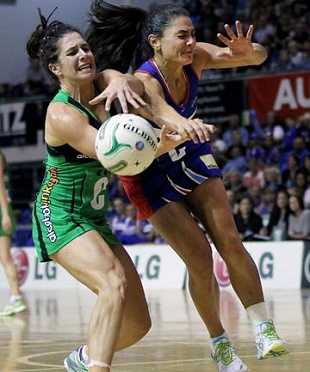What is the Obstruction Rule in Netball?
The game has several offside rules and regulations that relate to players obstructing the opposing players.
Netball’s minimum distance rule 0.9 metres (or 3 feet) penalises players for forced obstruction and physical contact.
Two netball infringements are fiercely regulated by any umpires officiating the game (e.g. contact fouls and obstruction penalties).
As a result, netball forced contact regulation (also called forced physical contact) is the sport’s most enforced law infringement.
Both infractions generally receive the same umpiring decision. Both of these types of netball fouls usually result in a penalty pass awarded to the obstructed team.
Marking in Netball Rules
- In netball you may get penalized for obstructing the player on the ball. A penalty also occurs if you obstruct an opponent who does not have the ball.
- A player forcing contact in netball with an opposer, either accidentally or by deliberate physical contact, is against netball regulations.
The official quote comes from the IFNA Rule Book PDF for netball contact rules and netball obstruction rules, and states that:
“No player may contact an opponent, either accidentally or deliberately, in such a way that interferes with the play of that opponent or causes contact to occur.”
Contact in Netball
Losing any defensive players through contact penalties disrupts the fast-flowing speed of the game. Thus, having players penalised for improper marking in netball also reduces your team numbers in play.
You should avoid making accidental or deliberate contact in netball. Avoid obstructing your opponents with your body or the ball whenever possible.
Interference of play also results in a penalty pass against the offending team. So, using unfair contact in netball, such as ‘pushing off’ or ‘backing into’ a player, would incur this type of netball sanction.
Netball Obstruction Rule
When players are defending in netball you can extend your arms to intercept the ball. But you must be no closer than 0.9 metres (3ft) to your nearest opponent.
The first landing foot of the ball-carrying attacker – to the foot of the closest defender – determines the minimum distance allowed.
You cannot shorten the minimum distance of 91.44 cm by arm extending or jumping to intercept the ball. This ruling is ‘obstruction advantage’ in netball terminology.
Double marking in netball, or obstructing a player with the ball, results in an obstruction penalty pass awarded to the opposing team.
You can position yourself close to an opponent without the ball. Even so, you cannot use your arms to intimidate or contact the opponent.
There will be no penalty if the attacking player shortens the regulatory distance to a defender while throwing or shooting the ball.

Netball Marking Obstruction
Defensively marking a player off court three feet away is the essence of the netball game. Being skillful in this component reduces the number of free passes given away. Even so, some situations allow the players to have ‘outstretched arms’.
You cannot mark a player with your arms outstretched. But, you can extend your arms if you are marking them off the ball and attempting to:
- Catch, intercept, or deflect a pass.
- Retrieve a rebounded ball from an unsuccessful goal attempt.
- Signal momentarily for a pass.
- Show the intended direction of movement.
Rule Recap: Obstruction in Netball
Obstructing the ball player closer than 91.44 centimetres results in a free pass awarded to the opponent. As play resumes the offender must stand beside the player with the ball while they play the free pass.
Note: The short video clip explains more about the netball rule for obstruction of a player in possession of the ball.
What is the Offside Rule in Netball?
Netball offside regulation keeps each member of the team inside their designated playing positions, as per their assigned role in the team.
Wandering outside your court offside zone, with or without the ball, results in an offside position. The opposing team wins a free pass taken inside the same area.
The netball offside rule allows players to take the ball from an offside area. But, only if no body part contacts the ground in the offside zone.
Two opposing players may both go offside in netball without penalization, providing neither of them handle the ball.
You can move out of court at any time but only if you do not have contact with the ball. A player must first make contact inside the playing area before attempting to touch the ball when moving back into court.

